Last month I traveled to Minnesota and had the opportunity to tour a couple of pig farms. That’s when I gained a whole new appreciation for where my food comes from. This is what I learned about pig farming…
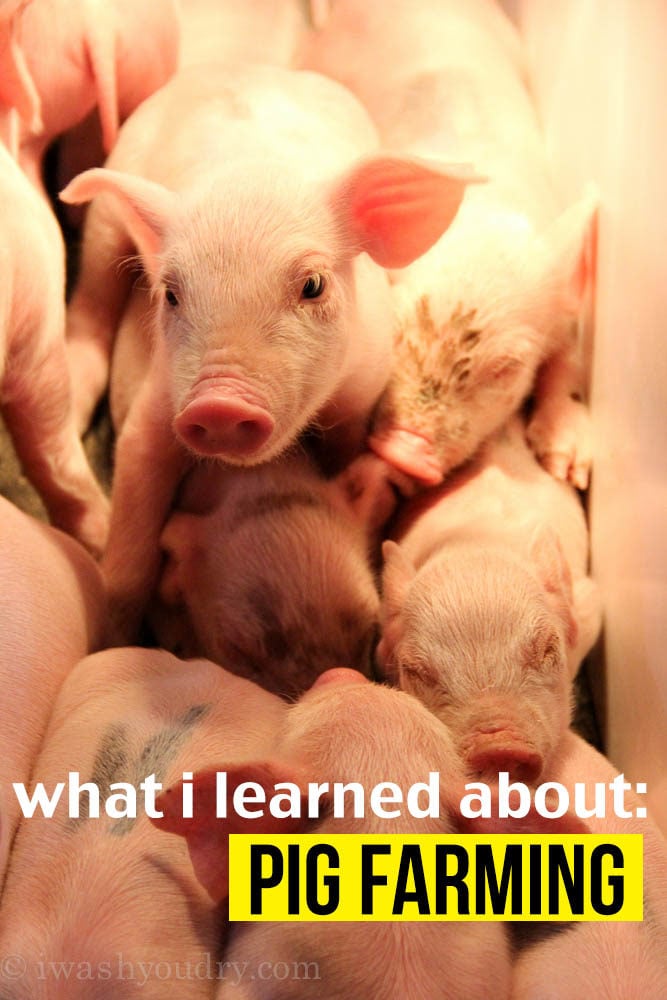
Like many of you, I had seen my fair share of sensationalized documentaries about the pig farming industry. I was eager to see behind the scenes for myself and the farmers were willing to answer any and all questions I had.
I encourage you to take the time to read this post in it’s entirety, if you have any questions or comments, please leave them in the comments below.
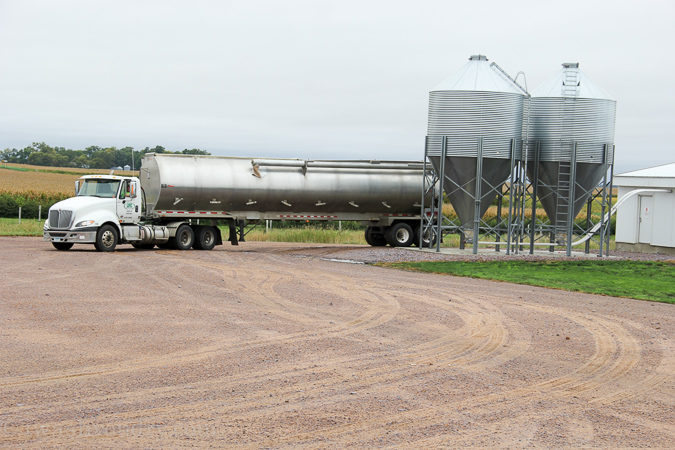
My tour started on the family owned farm, Wakefield Pork Inc. This busy farm is nestled in a small farming community outside of Minneapolis, Minnesota. An adorable couple, Mary and Steve, started the farm back in 1991 with just a small barn in their backyard. Over the years the farm has seen much growth and the company has now spread to over 2400 pigs, with several contractors spread across a few states.
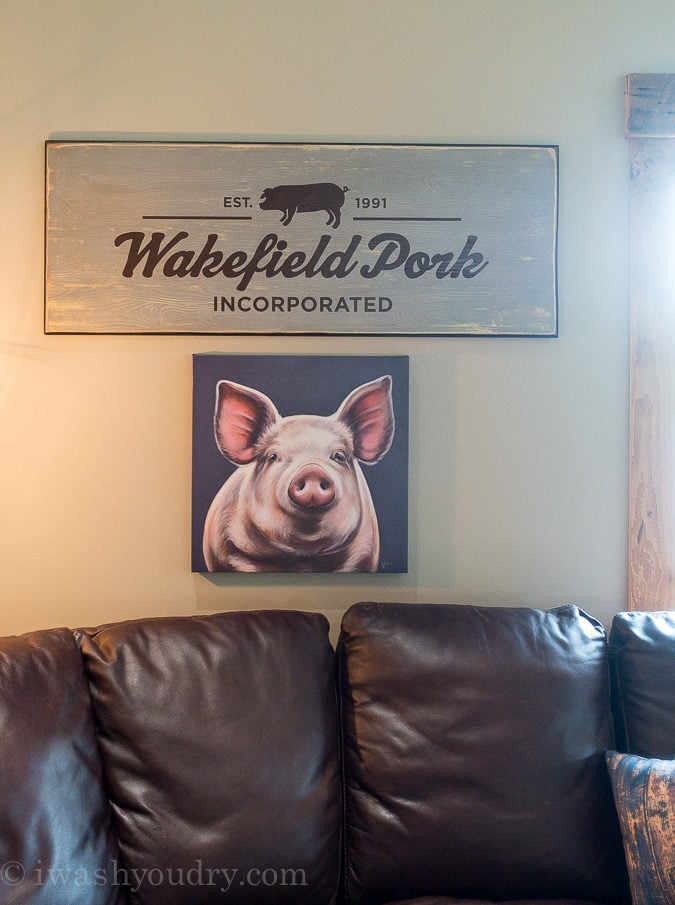
The first day of our tour we entered the Wakefield farrowing farm, but not without completely undressing and taking a head-to-toe shower. WHAT?!
Yeah, you read that right.
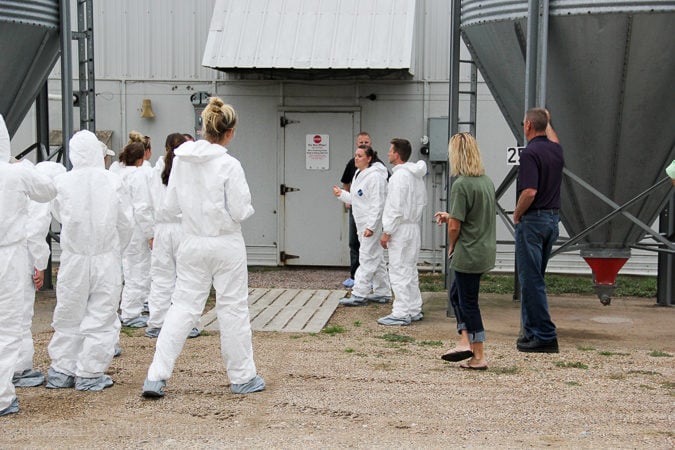
Farrowing farms are for the large sows (adult female pigs) that are bred for making babies. Here, the health and wellness of the pigs is in high priority. No one is let in (or out) without taking a shower first. Think of a maternity ward in the hospital, only a lot more strict. The whole farm is indoors, with heavy duty air vents that are equipped with hepa-filters. These steps for extra cleanliness have greatly increased the survival rate of the baby piglets.

The whole process of farrowing (having babies) is completed at this one location. The piglets are born and kept with their mama until they reach about 18-19 days, then they are shipped off to a “Nursery Farm.” The Nursery Farm keeps the pigs until they reach 50 pounds and then they are shipped to a Finishing Farm, where they are kept until they reach approximately 300lbs.
WHY DO THEY MOVE FROM FARM TO FARM?
Back in the day the pig farmers would have the whole process in one location. Farrowing, Nursing, and Finishing. Some still do. The Wakefield farm has been a leader in the pig farming industry by separating this process, and doing it with hugely successful results. Since the 1950’s pig farming has increased it’s productivity by 50%, while REDUCING water use by 40%, land by 80% and it’s carbon footprint by 35%. By separating the pigs in this fashion, they’ve also reduced the loss of pigs due to disease.
WHY DON’T THEY LET PIGS ROAM FREE IN THE MUD?
This was a question I had, and definitely asked. The pigs are kept inside, in a climate-controlled environment, with what I would describe as small slits in the floor underneath them. These small slits allow the pig’s waste to make it’s way down to a concrete lined holding tank, keeping the pigs cleaner and healthier.
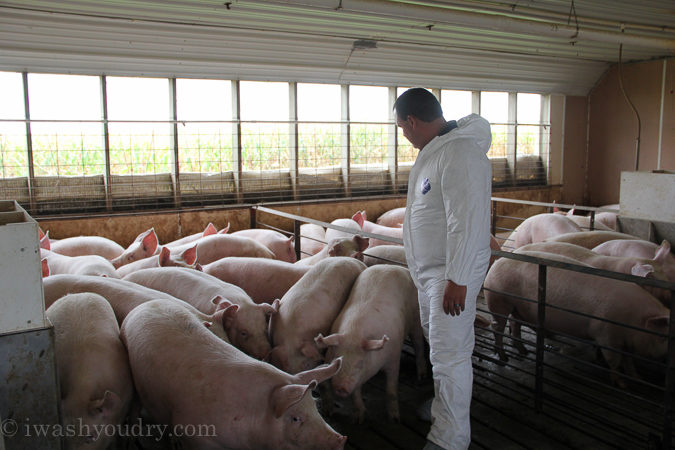
Farrowing sows (pregnant) are usually kept in a solitary pen. This was a little shocking to see at first, and my first instinct was to feel sorry for them. Then we were told about “the pecking order.” This is a real thing that happens naturally with animals. I should know, I have 3 backyard chickens and I witness this firsthand on a daily basis. It’s natural that the big will pick on the small, and that’s exactly what these sows do when they live together. It’s like high school all over again. By separating the mamas, they are kept healthier, not injured AND the farmers are able to closely monitor their food and water intake. It’s really a happy and cozy studio apartment style pen.

Piglets, nursery age pigs and finishing farm pigs are kept in larger pens together. I asked Steve (the owner of the farm) how he knew the pigs were happy. He said, you can see them almost jump with excitement and curiosity. When we saw the young pigs at the finishing farm, they came right up to us and I could definitely tell they were happy.
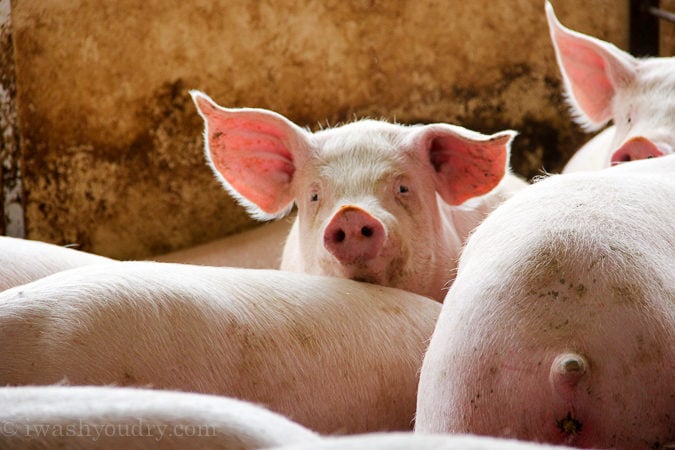
WHAT DO THEY DO WITH THE PIG’S WASTE?
Most farmers who have adapted to the system with the holding tanks underneath the pigs use the waste in its entirety. The waste is treated with enzymes that break it down and liquefy it. It’s then pumped out twice a year and used as manure for the crops that are grown to feed the pigs. I asked what they do with leftover waste (if they have any), and was told that it is sold to other farmers who are in need.
It’s really a never-ending cycle of sustainability. They feed the pigs corn, the pigs produce manure, and the manure is used to grow more corn!
WHAT HAPPENS TO THE MAMA PIGS?
The sows (mama pigs) are kept at the farrowing farm and produce an average of 6 to 7 litters per sow in their lifetime. At the Wakefield farm their sows are averaging 15.5 piglets per litter. The gestational period for a sow is exactly 114 days. For those that are wondering, that’s 3 months, 3 weeks and 3 days! How cool is that!?
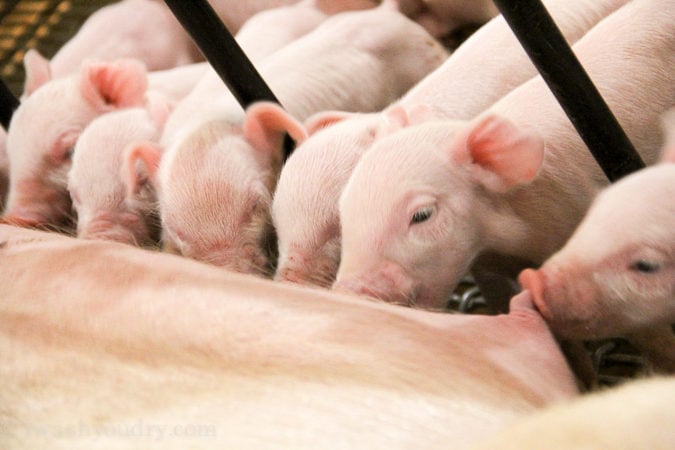
Back in the day they used to have plenty of boars (male pigs) around to impregnate the sows, but this method was costly. One boar to one sow. Wham bam, thank you ma’am. Obviously this wasn’t a very efficient method, when there are thousands of sows ready to go. Now the farmers get the ejaculate from one boar (3 times a week) and are able to inseminate 30 sows per collection. This method cuts down on the amount of boars needed to be fed and is much more efficient, ultimately reducing the farm’s carbon footprint.
WHAT HAPPENS TO THE PIGLETS?
This was probably my favorite part of the tour. The birthing room! When the sows are ready to give birth they are brought to a quiet room and give a larger pen with room for their piglets. I was able to witness a sow giving birth and even helped in the delivery!
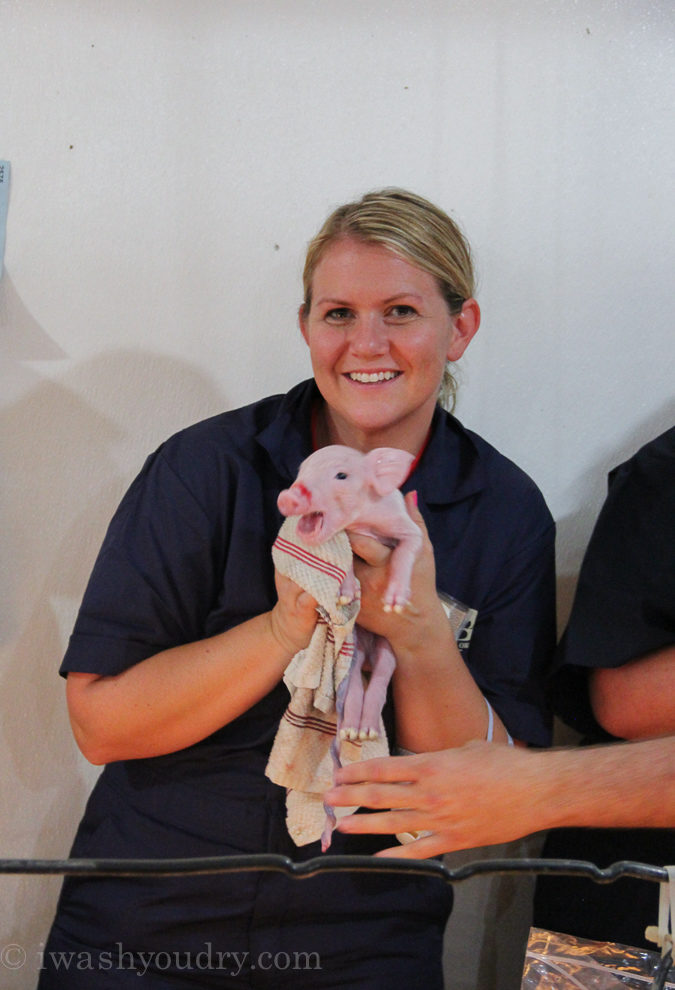
The babies are kept with the mama for 18 days, where they nurse and sleep. Much like any other baby. They are kept warm and are monitored daily for their growth and health. The babies will eat every 40 minutes, so you know that mama is working hard to produce all that milk!
In just a few days the piglets will rapidly gain weight. By the time they leave their mama they will reach up to 20 pounds! From here they are taken to a nursery where they are fed and brought up to 50 pounds, which takes another few months. After that, the pigs are sent to a finishing farm where they play in their climate controlled pens, eat lots of food and enjoy life until they reach about 300 pounds.
WHERE DOES THE PORK COME FROM?
Once the farrowing sows have reached their final days and are no longer producing piglets, they are sold off for meat. Since these sows are so large and have used their muscles for those babies they are used to produce sausage, pepperoni, hot dogs, etc.
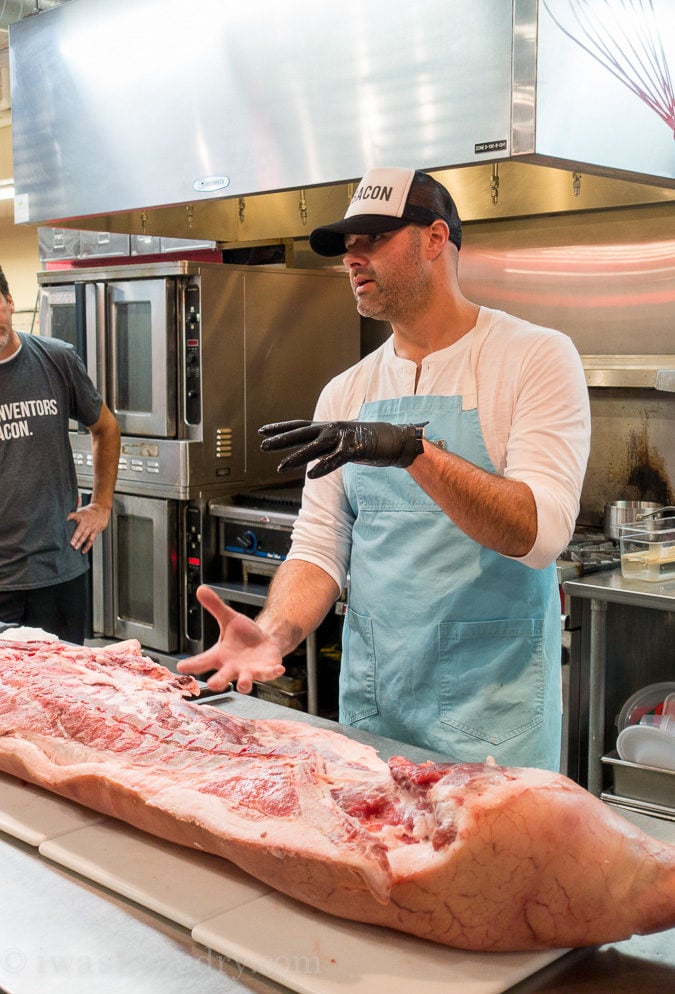
The pigs that were at the finishing farm are used for your typical cuts of pork – chops, ribs, BACON!
We were able to spend an afternoon working with all the different cuts of pork, playing around in a commercial kitchen, and then enjoying all the good food.
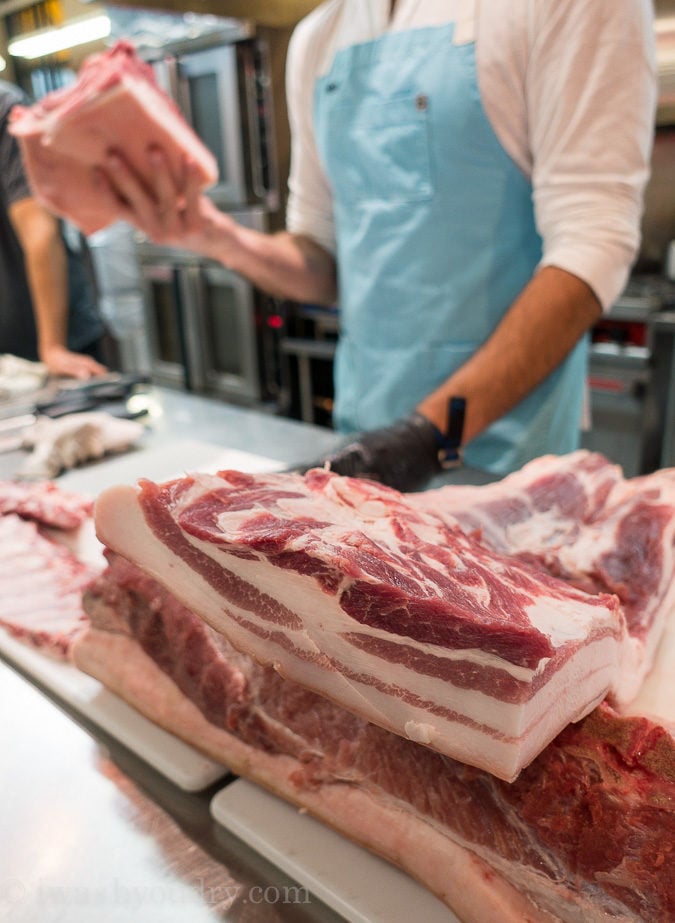
I’ve really gained an appreciation for where my food is coming from, and the love, science, technology and hard work that’s put into it. There is no one that works harder to keep Americans fed than our farmers.

If you have any other questions, PLEASE ASK! I took so many notes, and feel like I could probably write a book on it.
Make sure you don’t miss a thing! Follow I Wash You Dry here:
FACEBOOK | PINTEREST | GOOGLE+ | TWITTER | INSTAGRAM | BLOGLOVIN
disclaimer: This post is in partnership with the National Pork Board. All thoughts and opinions are 100% my own. Thank you for supporting the brands that help make I Wash You Dry possible.

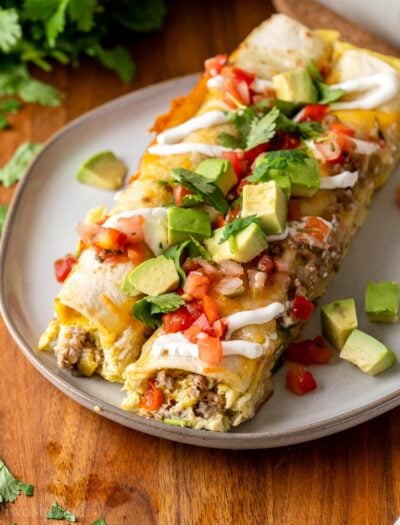
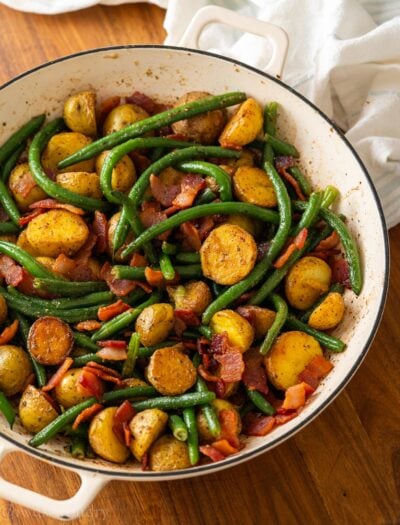
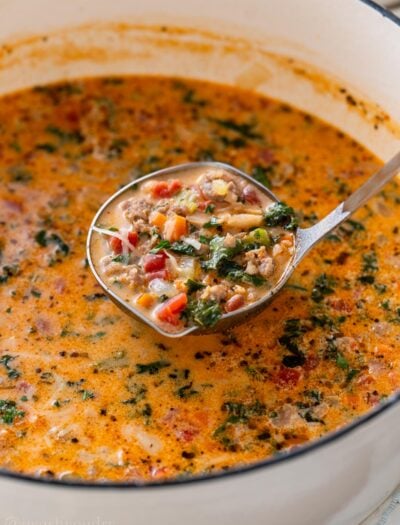
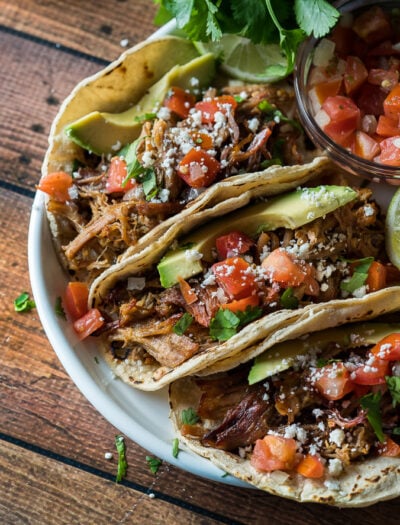
I’m happy you have such a positive experience. Unfortunately, your sugar sugar-coating the horrible hell these pigs go through. I was married to a big farmer who got 5,000 nursery pigs every six weeks. It’s nothing like you say it is. In fact it’s the most heartbreaking, RIP your got-out experience. They are not living in a little hotel. They live in overcrowded cages of filth. I won’t ruin your fairy tail. The truth needs to be told.
This is a well written post, but it kind of breaks my heart too. Pigs are about as intelligent as a 3 year old child, so the confinement conditions these pigs are raised in are inhumane. Can you imagine a 3 year old never getting to run, and play? Never feeling warm sunshine and grass underfoot. Not to mention being in a cage, for at least 18 days straight, unable to turn around. That’s just… Horrible. I saw mentioned in the comments that climate controlled was better as it was more sanitary. This is a ridiculous statement. Pigs are very clean animals. When raised with plenty of room they usually pick a designated spot to go to the bathroom. They do wallow in mud, but that’s due to the fact they have no sweat glands and that is how they stay cool. I’m glad you had a good experience, but I hope you get to see pigs on pasture someday. Now those are some happy pigs.
Merely a smiling visitant here to share the love (:, btw outstanding style.
I really enjoyed reading this post. It was thoughtful and informative. I can honestly say I learned something new! I am going to share this with my students who are completing a food unit. As a teacher, I thank you for taking great notes.
Dear Shawn:
Let me say from the onset that I am a vegetarian. I also appreciate the article and insight into what this family farm does to raise pigs. This farm seems to be the exception to the rule. I personally choose not to eat meat for ethical reasons, because I passed a veal farm every day during my travels to and from graduate school in rural Ohio.
You preface the article by saying that documentaries are sensationalized but I disagree. The documentaries focus primarily on factory farms where animals walk and lie in their own excrement and the meat has to be bleached to before it can be eaten. They are stuffed into buildings that they can barely turn around in and are then led to an inhumane slaughter. This is where most meat originates before landing on the grocery shelf. These kinds of farms are strictly off limits to outsiders because the meat industry knows what the backlash would be if found out by the public. When we talk about “free range” anything, it is exactly as I have described. Their range just happens to be inside a building. There’s not much “free” about that.
I understand that this farm is more palatable than factory farms. The majority of people don’t even associate meat wrapped in plastic, put under red lights to make it more appealing, with animals. It takes away the gruesome parts of consuming meat. Eating meat is a choice just like mine to be vegetarian. What I want is that people are educated to know the source of our food in order to make informed choices.
Thanks for allowing me to express my opinion.
These pigs live in hell! This story is a co.plete lie. The audacity to say ” they are happy” is enough to make me puke.
You said the sow produces 6 to 7 litters a year. The math doesn’t add up. 3 months, 3 weeks, 3 days. Maybe 3 litters a year.
It should have said in their lifetime, not in a year. I’ll get that fixed! Thanks!
Shawn! Thank you so much for joining us. I loved getting to meet you. I hope to see you soon 🙂
Shawn;
THANK YOU for your insightful blog post on raising pigs. My 11 year-old daughter raises pigs for others to butcher. We use no medications whatsoever and people love drug-free meats. Our place is clean and our hogs are very content. This makes a big difference in their health. She makes some money for her future and learns responsibility through cleaning the pens, feeding and watering, buying feed, measuring for their growth and selling the finished pigs. It’s funny that pigs can give so much education and provide us with a healthy source of nutrition! Thanks again…
LOVED this post and loved reading about your experience, Shawn! So happy to have met you on this trip!
Wow, Shawn, thank you so much for sharing the interesting facts about raising pigs!
I loved all of the piggy pictures, they do look happy and clean!
Hey Shawn, this was a great article! Some of these comments though…geez. I don’t understand why people would rather eat pork that was rolling around in slop and waste than kept in a controlled environment. Those are the same people chewing on a bacon cheeseburger while they are leaving a rude comment. People need to get real about reality and how things work. There are 300 million people in the US, most of which eat some form of pork from time to time and it’s not even realistic to think these pigs are living in a field of Daisy’s prancing around singing “You are my sunshine” while waiting to die. I’m sure this post wasn’t easy just because you never know what to expect from people but I say thanks for telling the truth and whoever doesn’t like it, can go be a vegetarian.
Sorry, I don’t mean to be rude, but do a little research on pigs. Pigs do wallow in mud but not in their own waste. Pigs pick a bathroom area to use. Pastured pork comes from happy pigs AND it’s healthier!
That is the most interesting thing I have read in awhile. I loved learning about the pigs and how they are born, taken care of and end up on our table. We know that the meat we eat is clean and free from disease.
I know when I was a kid and my father ran a meat packing plant, there were many times large worms were found when butchering. Animals were sick and had to be destroyed. That method was pure waste and very unhealthy. I am glad you published this for us as it makes me feel better about pork products.
Thank you for taking the time to share your experience. It was very informative. However, I agree with Kay regarding this being inhumane in some ways. It’s sad to think these creatures are completely confined indoors their entire short life, from birth to slaughter. While the farmers make sure conditions are clean and sanitary, it is still a pig factory. Also, I do believe the term is “farrowing sows” not “furrowing sows”. If I didn’t live in the country I wouldn’t have known that. ; ) Again, thank you for sharing your experience with us. It was very informative.
Hi Elizabeth, thank you for taking the time to read and share your concerns. I thought the same thing about the pigs, but after talking with the farmers and learning how disease can quickly eradicate a whole farm, the need to keep them clean and in a disease free environment is necessary. You wouldn’t want to leave your child out in the mud, in harsh conditions, with the chance of not getting enough food, just so it had the opportunity to be outside. The same goes for the pigs! It’s all to keep them healthy and happy. And trust me, those pigs I saw were happy little guys! 🙂
I’m a HUGE lover of all things pork. I would have never believed raising them could be such a clean operation. Very interesting article. Thanks so much.
YES! The cleanliness was definitely a shocker for me! I would have never guessed it to be that clean for pigs! 😉
Thank you for informing the public about family farmers. These people work so hard to provide you with healthy food for your table. There really are people producing your groceries, it doesn’t magically appear on on the grocery store shelf.
It was so fascinating to see the behind the scenes of it all! Thanks for your comment! 🙂
I started to read the article but then the usual popup ad took over my phone and I had to shut down the page just to get rid of it. The article looked interesting but it’s sure as heck not worth putting up with that so I’m skipping it altogether. I get it that you advertise to make money and I support that it you should really check to see what kind of stuff the ads do to your page. At this rate I might just unsubscribe, because what’s the point if I can’t even look at the recipes?
Hi Devon, I’m so sorry you had an issue with a pop up. I understand they can be annoying, I’m working on ways to reduce the need to for ads. Thank you for your comments. 🙂
I still feel it is a very inhumane way to treat animals. How would you like to be confined in a small pen inside a building all of your life. Not too much fun huh? Bottom line for the corporations is money, money, money!
Hi Kay, I can completely understand your concern for the animals. The health and wellness of the animals is the farmer’s top concern as well. This is why the animals are kept indoors. If they were kept outside in the mud, rolling around in their own waste, then the pigs would not live healthy lives. The land would be destroyed, there would not be adequate ways to ensure the pigs are being fed properly, and the chances of a whole farm of pigs being infected with disease and dying would be much higher. I can assure you, these pigs lead happy, healthy lives. They are not confined in solitary pens their entire lives. Only when they are pregnant in order to ensure their safety. Hope that helps clear some things up for you!
It is called the FOOD CHAIN.
That was fascinating…thanks for sharing
You’re very welcome Kate! Thanks for commenting!
I read to the end and was absolutely fascinated by your visit to this farm.
Thanks Michelle! I appreciate you taking the time to comment! 🙂